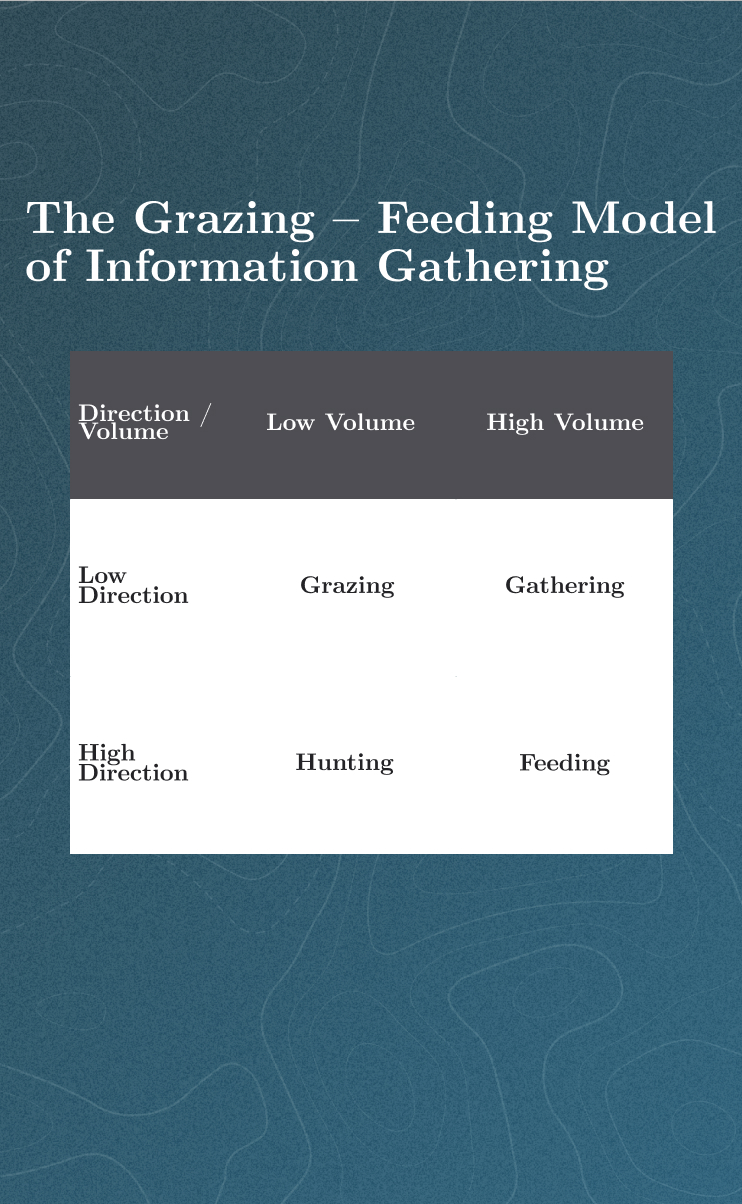Knowledge Ops
The Grazing – Feeding Model of Information Gathering
On the Internet, information is limitless. The Grazing-Feeding Model of Information Gathering helps you know how you're engaging with that information.

One challenge today is managing all the available inputs at our disposal. Whether you're a researcher or just someone who's universally curious – the Internet has everything you could want to know and more.
If you haven't seen it yet, Bo Burnharm's "Welcome to the Internet" is a fantastic take on this:
The problem this creates though is that it's sometimes hard to know whether the way you're currently engaging with all that information is actually how you want to engage with it.
The Internet is fantastic at sucking you into rabbit holes that are really cool to explore, but pull you away from what you want to be doing. To counter that, I find it helpful to put names to what I'm doing, so that I can check whether a given "mode" I'm in is the mode I want to be in.
Two Axes: Direction and Volume
I've come up with two main axes for thinking about different modes of gathering information: direction and volume.
Direction refers to how well I know what I'm looking for – am I doing a directed search on Wikipedia, Google Scholar, or Youtube? Or am I browsing around, following where the links take me?
Volume refers to how much information I'm looking for – do I want to look up a specific fact, or get a full download of everything on a specific topic?
Because keeping these two axes in mind can be difficult in the moment, I've come up with a 2x2 matrix that gives the combinations names that are easier to visualize.
From Grazing to Feeding
Here's the 2x2 that maps direction and volume against each other:
| Direction / Volume | Low Volume | High Volume |
|---|---|---|
| Low Direction | Grazing | Gathering |
| High Direction | Hunting | Feeding |
What do the different fields describe exactly?
Low Direction, Low Volume: this is what I call grazing. It's basically like Wiki-walking while you're on the subway, or browsing a news site or subreddit you like. You're not looking for anything specific, and the volume of information you're consuming is relatively low.
Low Direction, High Volume: this what I call gathering. It's exploring a wider field of sources and topics with a sense of "I might need this". You're not looking for a super specific subset – it's more "let's read about philosophy today" and then going where the reading takes you. You follow links and references because they sound interesting in the moment, not because you want to check whether they have a specific nugget of info you're looking for.
High Direction, Low Volume: this is hunting for information. You're not looking to learn about a field, you're not interested in encompassing treatments of a subject – you're looking for one specific aspect of a topic, or one particular source. That means the volume of information you're looking for is limited, but you know exactly what you want. You're on the hunt for information.
High Direction, High Volume: this is feeding. You want to get up to speed on a new field, and you want to do it fast. You're trying to make sense of a large volume of information, dozens of sources among known categories – you're feeding yourself all the information you can get on something.
With this little framework I find it much easier to check myself in the moment.
What am I doing right now? Am I grazing or gathering? Do I actually want to hunt or feed?
Related Topics
Join the Cortex Futura Newsletter
Subscribe below to receive free weekly emails with my best new content, or follow me on Twitter or YouTube.
Join and receive my best ideas on reading, learning, and Knowledge Ops
